
Полная версия
H. R. GIGER TAROT
Interpretation
1 Chaos (The Beginning)
Chaos is shapeless primal matter out of which everything emerges. It is the first act of the creative force that “generates itself” and then ignites its own idea. It is an eruption of flames, the overflowing power of which destroys existing forms so that the life force can flow into new forms. In spiritual cosmogony, chaos represents the bridge between the spirit and the idea. It is a symbol of the inner firepower underlying outer endeavors as an invisible inner impetus.
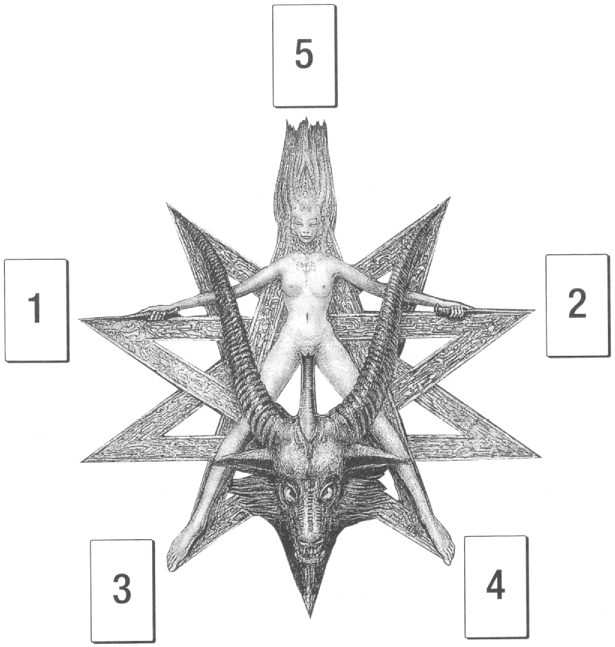
2 The Quark Era (The Creative Quality)
This era corresponds to the absolute primal idea of the divine manifesting itself as matter and penetrating into the world of forms. It is the spirit of the will, and of God’s spark, which conceal itself in form. Even during those first milliseconds of the young universe, it laid the cornerstone for continual development right up to the present day. The Quark Era only lasted about one ten-thousandth of a second. On our level of human creation, this means that the second card reflects the creative quality underlying our idea.
3 The Hadron Era (Dynamic Energy)
The third card shows the dynamic quality of our idea on the energy plane, meaning how the potential energy may assert itself (in the world) within the entire whirlwind of creation. Even in our inner experience, we must also accept the hectic phases that accompany outward changes and upheavals. Inner unrest originates in a creative urge to burst the framework that has become too constricting to the awakened spirit of fire. This corresponds with the cosmogony of the Hadron Era when, for some ten-thousandths of a second, the universe consisted almost exclusively of hadron, the smallest component detectable to physics in the atomic nucleus.
4 The Radiation Era (Compression)
The fourth card symbolizes the arrival of the atomic nucleus comprising simple chemical elements; namely, nuclear synthesis or genesis. The Radiation Era stands for the genesis of things from the unchanging, complete, divine oneness and for the slow compression of energy in time and space.
5 The Material (The Appearance)
Approximately half a million years after the big bang, energy had compressed so much that electrons were taken up by the atomic nuclei and were therefore able to form the first stable elements. The universe became visible: “And there was light!” This phase represents the spirit of creation in its most concrete form since divine ideas now appear in visible form and reflect back upon the creator in the act of giving birth to creation. On the psychological level, the fifth card therefore reflects the point in time when our ideas become manifested in the material world as miniature symbol of God’s creative presence (creatio continua). However, this occurs in the form of transcendental – and not causative – effects.
V MEPHISTO’S HAMMER
Questions
Let us just suppose that we are sad, depressed, and distressed. Nothing succeeds and we are blocked in everything we do. This is the appropriate precondition for this spread because depression is the key to clearer understanding (What is this crisis trying to tell me?). The cards point to an insight we require in order to recognize the meaning of our failure (What unconscious meaning is at the root of my failure?). Perceiving the unknown motivation, and not overcoming the crisis as quickly and painlessly as possible but without gaining in experience, is the meaning behind every failure.
In short: We do not perceive because we enjoy understanding, but perception is frequently the only experience that help us become acquainted with the conditions and basis of our self-deception. As a result, it becomes the precondition for eliminating it. If we do not willingly accept what wants to achieve realization within ourselves, it will be forced upon us. This way of fulfilling our destiny is naturally not particularly pleasant. Yet, it always also initiates healing, a process of development so that we can find our own center. Because they are the results of our own actions, personal catastrophes not only force us to be honest: They also make us complete because they bring into the world that very part of ourselves to which we are most blind. The cards therefore permit greater consciousness: through them we perceive the circumstances that make “sense” of our failure.
Allegory (The End of Creation)
John Faust looked intently through the ocular of his telescope and furrowed his brow. He did not like what he saw there at all. Not far from Pluto, the most distant planet from the sun, he had discovered a comet, one of those unfathomable wanderers in the universe forced by the gravitational pull of the distant planets into an orbital path around the sun. This in itself was nothing remarkable, but in this particular case it was such a titanic size as to present a danger, for it steered a direct path toward the earth. “I tell you, it’s going to cause problems. And why, I ask myself, has no one already sighted this stray from the depths of nothingness?” He pointed to the cosmic monster as it plowed through the night sky outside.
His colleague, M.E. Phisto, lit up a cigarette pleasurably and merely said: “Yes, yes … humanity has its little secrets that it likes to hide from itself What will it do now that everything is about to dissolve? Do you want to hear the truth, brother, without the inherited genetic blindness, which is such a mark of the human brain?”
He laughed: “They will do nothing at all. First they will panic, and then repress it all once again. They will become slower and slower and stop, just like the mechanism of a broken clock! The spirit, a quasi-conscious being, grown weary of the Earth and is preparing to abandon this tumbling spaceship. For it is already written in the Bible: ‘and the stars will fall from the heavens.’”
Faust turned towards him and slowly nodded with strangely void eyes: “Yes, this comet out there is like the divine spark that destroys everything. Like the final crescendo of a Devils symphony calling itself human development. We cannot stop it. It would be blasphemy to try! But perhaps our essence will survive the doomsday if our souls strive to reach God again. Who knows!”
Faust and M.E. Phisto announced their discovery. Their scientific calculations proved to be correct – that the cosmic messenger of the Devil would not elegantly slither past the inner planets and the Sun, but rather, that it would crash directly into the Earth. Then the world was seized by great fear and the bringer of death was called “Mephisto’s Hammer.” But horror soon gave way to stubborn despair, and the closer this tool of the Devil drew to Earth, the madder the party became. The nearer the sword of Damocles descended upon the heads of the human beings, the more they felt compelled to repress their fears. But the “Hammer” did not miss its target! With the enormous force of countless atomic bombs, it went down in the Caribbean Sea south of the Greater Antilles, annihilating all life on Earth in a single inferno.
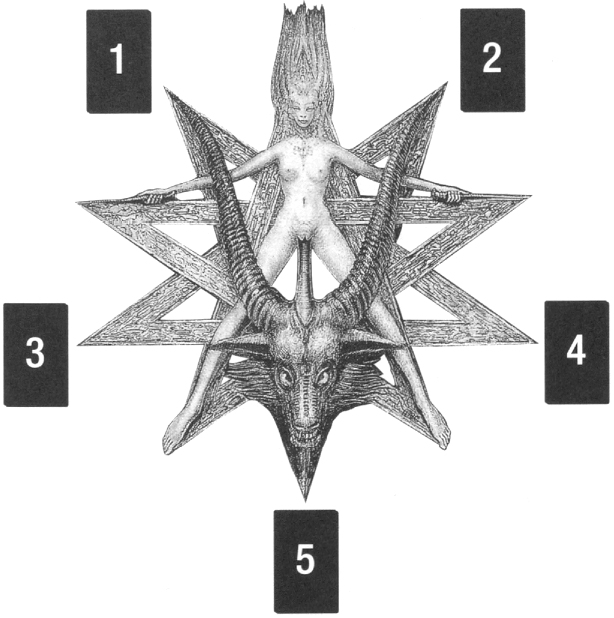
Interpretation
1 The Impact (The Theme of the Crisis)
The impact means suddenly being torn from a harmonious state. It is the destruction of a stable system of balance. It therefore represents the subject of the crisis.
2 The Deluge (The Consequence of the Crisis)
The impact of a comet striking the ocean triggers off enormous tidal waves all over the world; they roll towards the coasts with deathly force. The second card therefore symbolizes the aggressive destructive power of the crisis because it “surges above” its own barriers and forces its way from inner seclusion into outer, manifested experience.
3 The Darkening of Light (Sexual Chill)
The sun’s light is eclipsed for decades by matter stirred into the atmosphere by as a result of the impact. Temperatures plummet throughout the whole world and most animals and plants do not have the right conditions for survival because they cannot adapt quickly enough to the altered circumstances. The third card is therefore life becoming extinct or the emotional nadir: the spiritual center of the crisis.
4 The Greenhouse Effect (Emotional Overheating)
With the settling of the stirred-up matter, temperatures quickly begin to increase again due to the enormous quantities of carbon monoxide released through the firestorm caused by the impact of the comet. This releases huge amounts of carbon dioxide that have a greenhouse effect. The heat consumes whatever life that remains. This card is therefore an allegory for overheating within the soul or the pressure of pent-up feelings.
5 End and Beginning (Human Beings)
The fifth card symbolizes the renewal that is fulfilled in the resurrection of human beings. Because the light reaching us today from distant galaxies was radiated millions of years ago, each look into the universe is a view into the past. Those human beings existing a million years from now will probably have emerged from the life forms surviving the present catastrophe. Consequently, this card does not show us the steps to take to overcome the present crisis on the psychological level. Instead, it depicts the goal towards which our development will lead us after the crisis is overcome.
VI THE NOHNS’ WHEEL
Questions
The thing we call “fortune” is the manifest expression of the process of transformation that we experience in our lifetime. These show us the structures concealed within the deeds, which are both cause and effect to the same degree. Therefore, we are not prisoners of the Norns’ Wheel, but wanderers upon a path that leads us through the effects of our own actions. Although this means that we do not have the power to alter our destiny, we can still change our view of things. The vital question of destiny is not what we are able to change in the current situation, but what is the meaning of our actions: the goal towards which our development is heading.
Background (The Norns of Destiny)
This spread is a combination of beginning and end, of the Big Bang (IV) and the Hammer of Destruction (V). It links the polarities of creation and destruction to the steady movement of the Norns’ Wheel that, because it spins eternally, is therefore between the two. The question that moves you is the point of intersection through which you focus the journey to yourself (between birth and death). You must accept that everything you experience is in turn never the actual cause but only a ripple triggered by pre-existing causes that can themselves be traced back to a basic pattern increasingly distant in time; effects following causes that can be found in your spiritual development. Everything that you experience is never just the cause but also the effect of a genealogical pattern pressing tirelessly further into the future. As the subject of your question (and the focal point of your increasing consciousness) it swings both back into the past and forward into the future. On the allegorical level the three Norns – who turn the wheel of Fortune, and therefore keep the cosmic cycles in motion – symbolize the inner laws that take effect in the actions of people.
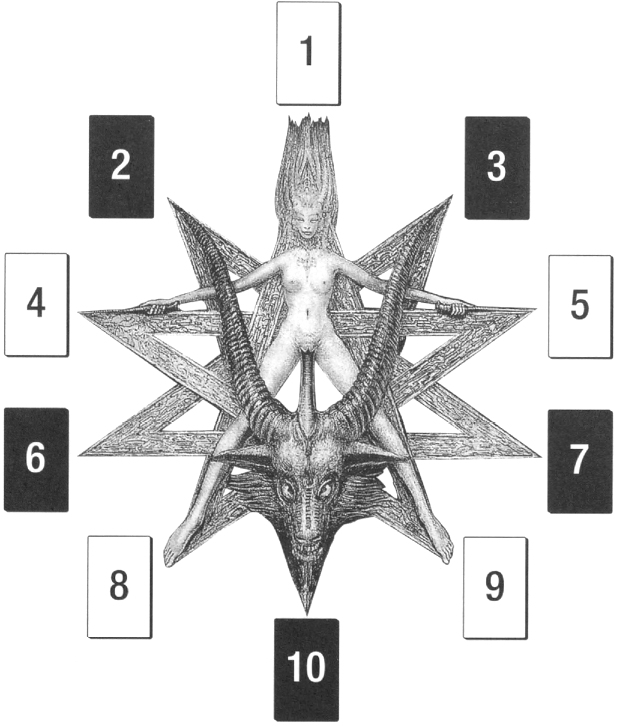
Interpretation
1 The material as the basis
The issue in question.
2 The impact as resistance from outside
The shadow you encounter outside yourself.
3 The flood as a consequence of this resistance
The physical plane, upon which the shadow manifests itself.
4 Chaos as the primal beginning
The first opportunity dawning on you in the fog of numinous fears (the aim).
5 The Quark Era as creative quality
The higher (spiritual) meaning of your action.
6 The cooling down of the Earth as inner frustration
Emotional resistance.
7 The Greenhouse Effect as emotional overheating
The inner (exaggerated) reaction to external resistance.
8 The Hadron Era as physical assertion
The dynamic quality of your actions.
9 The Radiation Era as physical condensation
The compression of your aim (hopes and fears) in time and space.
10 The human being as the outer goal of our development
The goal towards which your development leads.
VII THE FIVE-RAY SPREAD
(THE PATH OF DECISION)
Questions
What shall I decide to do? Should I buy a car? Resign from my job? Take a holiday? What’s going to happen if I do it? And what’s going to happen if I don’t? What’s the right path?
Background
This spread is only appropriate when we cannot decide in favor of one or the other possibilities. The right-hand side (the left from the reader’s perspective) describes the active possibility (if we do it). The other side describes the passive possibility (if we don’t do it). In this process, the significator (card 1) makes it possible to psychologically clarify the background to the question since it reflects the personal state of consciousness, which is mirrored at the time of this decision.
Interpretation
1 The Basic Situation
The realities of those conditions that lead us to make a decision. This also includes the quality of the background of the question that you are currently interested in.
2 The Physical Level of Acting
The physical realm of experience if you decide to do it.
3 The Physical Level of Not Acting
The physical realm of experience if you decide not to do it.
4 The Emotional Level of Acting
The psychological realm of emotions if you decide to do it.
5 The Emotional Level of Not Acting
The psychological realm of emotions if you decide not to do it.
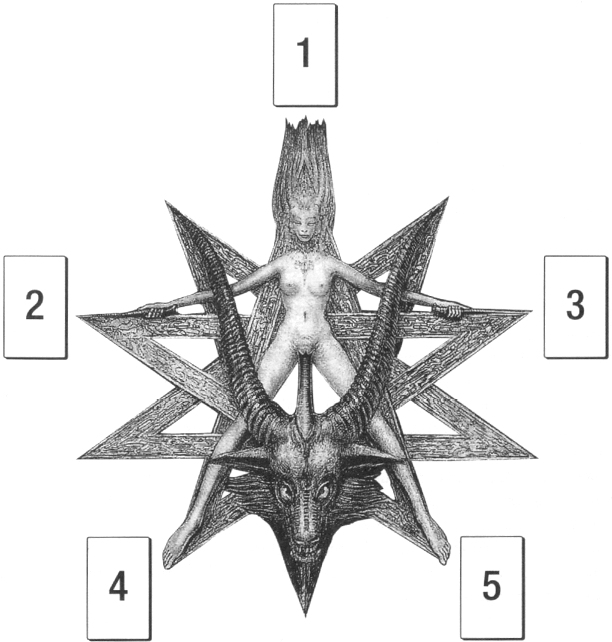
VIII THE NINE-RAY SPREAD
(THE RELATIONSHIP GAME)
Questions
• How do I see my partner and how does my partner see me?
• What shadow do I reflect in the other person or live out in my counterpart?
• How do I consider my relationship overall?
• What does my inner image of the relationship look like?
Background
This is about the relationship between you and your partner. In more precise terms, this is about making contact with the aspect of your partner that reflects you. None of us can be content with ourselves – or with what we consider to be ourselves. As a result, we need the other person, or at least the image of the other person, which corresponds to our expectations. A man experiences himself in a woman through his own unconscious feminine aspect (anima); the woman experiences herself in a man through her own unconscious male aspect (animus). We can emerge from ourselves only when we are prepared to accept that the opposite sex within ourselves can only be recaptured through a partner. Then we enter into a more complete form of the relationship: one in which our present self becomes the part that is only really “the complete self” when it integrates the image of our experience.
Allegory (Adam’s Rib)
The search for the self in the image of the partner is an emotional process, which has already been handled as a biblical allegory in the myth of Eve’s creation from Adam’s rib. It is usually interpreted by saying that this is how original man achieved first achieved the completeness of human existence – including partnership with the opposite sex. But it is also possible to interpret the myth in the opposite way: Adam was, so to speak, made “incomplete” by having a part of himself extended into the world so that he had to seek outside of himself and then integrate it within himself. In this myth of how woman was created, the seed had already been sown for expulsion from Paradise since it is practically an expulsion from Adam’s own self. The goal of human beings is consequently prescribed through God’s will: to reunite the separated parts of our own nature. The motivation to attain the original wholeness is the hunger for what has been lost. It is the hunger for that part of the self beyond the ego, forcing human beings to step out of themselves and into the world.
The door through which we come out of ourselves and enter into the world is our self. If our karma is good, we can certainly confront our inner tensions by perceiving what fascinates us in others as the unredeemed element within ourselves. But we must first understand that we only feel attracted by people towards whom we already have a willingness to be attracted. This leads us to the insight that the part we are searching for in others is the part of the self that needs to be reclaimed from world outside.
The “rib” belonging to us but existing outside of us is the mercy granted to us by God when we had to abandon Paradise and step down into duality. By rediscovering it, we will once again become complete and a part of God. Unless we recognize what is not redeemed within ourselves, we are incapable of any real relationship because we can never truly see or experience the other person separate from our own images and imagination.
Yet, as long as the karma is still clouded by the fog of the unconscious, we will project our unredeemed elements onto the world. Not recognizing them, we fight against them like an evil enemy. We will see through everything the whole of humanity can do for us because we intuitively feel that all things incomprehensible are working against us. With the help of outside circumstance, our projections therefore compensate for our attempted repression. Then we put the label of “destiny” (or chance) on whatever we inflict upon ourselves with the kind assistance of outside circumstances.
At this point, what displeases us in the other person can only be what plagues us in ourselves. For whatever does not plague us cannot be summoned into consciousness by the other. But, on the other hand, if we recognize that we can experience nothing in the outside world that is not already within ourselves, then we can finally discover that every encounter serves a single purpose: to encounter ourselves!
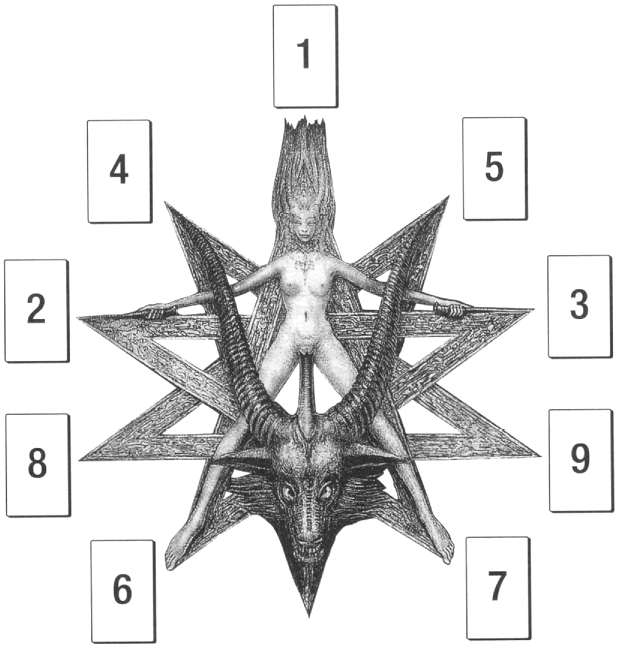
Interpretation
1 The Background of the Relationship
The issue of the relationship.
2 Your Own Relationship Plane
The plane of consciousness upon which you encounter your partner, what you think of your partner, and how you view the relationship.
3 The Relationship Plane of the Other
The plane of consciousness upon which your partner encounters you, what your partner thinks of you, and how your partner views the relationship.
4 The Animus or Anima
The anima of the man or the animus of the woman, meaning the opposite sex within us as seen in the image of the other. This card shows what you look for in the other or what you find within the other as a result of your own search.
5 The Animus or Anima of the Other
This is the anima of the male partner or the animus of the female partner reflecting in you: The man discovers his female aspect within the woman, and the woman experiences her masculine aspect as herself within the man.
6 The Unconscious Relationship Plane
The essence of cards 2 and 4 or the four combinations of man and woman, man and anima, woman and animus, and anima and animus.
7 The Unconscious Relationship Plane of the Other
The essence of cards 3 and 5 or the four types of contact (see card 6).
8 The Shadow
This is the shadow that you cannot tolerate in yourself, project onto the other, and consequently reject in the other: the counterbalance, so to speak, of card 4.
9 The Shadow of the Other
The shadow projected onto you by the other and fought by the other in its role as proxy: thus, the counterbalance of card 5.
IX THE TEN-RAY SPREAD
(THE CELTIC CROSS)
Questions
The Ten-Ray Spread takes the form of the Celtic Cross, the classic among spreads. It can basically be applied to any topic, but is particularly suitable for questions related to the trend of events:
• Where is my path leading me?
• What is the inner purpose of my actions?
• In what direction are my external aims developing?
• And how do I encounter the fruits of my actions in the external world?
Background
So that the messages received from the ten selected cards do not become too complicated, it is recommended that you first concentrate on the framework – the axes 1/7 and 4/10 – and disregard the other cards for the time being.
Card 1 then shows us who we are against the background of the question. Card 7 describes the psychological data bank (“inner self”) we have at our disposal from the rich store of individual learning and experience. At the same time, it provides hints about the final outcome – card 10, which sits in a state of grace upon the foundation of the soul (card 4). Card 7 depicts our spiritual power, or the higher self in which we appear “before the supreme being.” If card 4 is the unconscious character trait pointing to the verdict of fate (card 10), then card 7 is the higher aim of the ego (1) or the “path to the throne.”
If we consider this from a broader perspective, card 2 enables us to see the obstacle blocking our path in: the shadow, in so far as we redeem it, leads us to what card 7 shows us. Cards 5 and 6 indicate the background that constellates the problem relating to our current situation (3). The cards in positions 8 and 9 indicate the inner specters (hopes and fears) that we attract to ourselves from the world outside because they complement our inner disposition.

